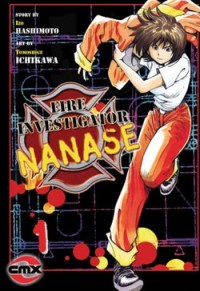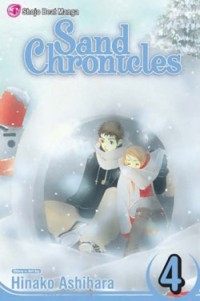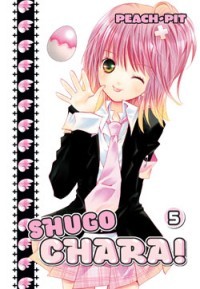RIGHT TURN ONLY!!
Shugo Chronicles
by Carlo Santos,

Among other things, Youtube has spawned all manner of niche musical artists—like people who cover anime-related songs on their instrument of choice. And like most internet things, these performances are, to put it nicely, of varying quality. After subjecting myself to countless Ievan Polkkas and Caramelldansens, however ... I think we have a winner.
FIRE INVESTIGATOR NANASE

Vol. 1
(by Izo Hashimoto and Tomoshige Ichikawa, CMX, $9.99)
FROM THE BACK COVER:
"Firefighter academy student Nanase is a promising rookie fire investigator, still haunted by her parents' fiery death. Three years ago, she saved a man from a burning building; he turned out to be the arsonist responsible for the death of her parents. Now this serial fire-starter has started helping her solve fire-related crimes. Can Nanase reconcile his willingness to help her with his role in her personal tragedy?"
EVIDENCE FOR:
If you've ever thought, "Hey, Detective Conan's brain-teasing mysteries would be even more awesome if they were combined with the adrenaline of the emergency response professions!", then check this one out. Not only does Nanase offer some pretty challenging whodunits with intricately placed clues (knowing the physics of fire definitely helps), but it also captures the urgency and uncertainty that comes with trying to understand one of nature's most volatile forces. Add in the intrigue of a mysterious rival/helper lurking in the shadows—the idea of a serial criminal passing on hints to the firefighter who saved him is psychologically fascinating—and this becomes something deeper than the average "solve a case and move on" series. But its greatest asset may actually be the pacing and flow of each chapter—the page layouts vary in size and shape throughout each scene, keeping things visually interesting while also leading with enough suspense from one moment to the next. And of course, with all the intense firefighting scenes and re-enactments, there's plenty of action and special effects to please the eye as well.
EVIDENCE AGAINST:
Exciting as it may seem, the adrenaline starts to wear off once the flaws are called into question. True, there's a deeper layer of story beyond the usual case-by-case plotting, but aside from having his life saved by Nanase, does the mysterious arsonist have any motivation besides "he just likes messing with people"?That kind of arbitrary connection—making the protagonist's worst enemy her most useful ally just because it seems cool—stands on shaky ground unless the characters are developed further. And if he's the one feeding her all the hints for solving each mystery, it makes Nanase's own problem-solving ability seem less compelling. Even the way she presents her conclusions, laying out all the clues and then dramatically pointing out the culprit, doesn't do much more than imitate all other standard-issue mysteries. Then there are the rather forgettable character designs, which diminish the series' visual appeal because even the lead roles look like side characters. When your brilliant firefighting girl detective is surround by drab-looking salaryman types, well, it just kind of dulls the edge...
FINAL VERDICT:
Although some story elements falter, few other series manage to blend suspense and problem-solving so effectively—that's B material right there.
ME AND THE DEVIL BLUES

Vol. 2
(by Akira Hiramoto, Del Rey, $19.99)
FROM THE BACK COVER:
"In Me and the Devil Blues, bluesman Robert Johnson, an American legend, has been completely reimagined. This fictionalized biography takes us deep into the heart of some of the darkest chapters in American history. RJ was a simple farmhand who dreamed of becoming a great bluesman. When RJ made a deal with the devil, he lost his wife and his mortal soul. Now he may lose his last remaining possession: his life.
Kidnapped by thugs, RJ is locked in a tiny cell to await mob justice. His only hope lies with gangster Clyde Barrow. Clyde, however, has problems of his own. Masquerading as a newspaper reporter, Clyde befriends Stanley McDonald, the most powerful man in town. Clyde is all set to help free RJ, but while staying in McDonald's mansion his discovers a chilling secret that could mean death for an innocent boy. Now Clyde must decide whom to save: the innocent child or his mysterious friend RJ?"
EVIDENCE FOR:
True fact: RJ does not play a single note of music in this massive 550-page volume ... but that doesn't stop it from being an epic masterpiece. When we last left our tortured musician and his gangster friend, the story seemed to have lost track of itself, but the payoff arrives here in stunning fashion, proving that Akira Hiramoto is just as adept with action-packed crime drama as with fantastical biography. Tension and momentum push these chapters forward at every turn, as small-town treachery morphs into a breathtaking jailbreak which then becomes a heart-stopping manhunt. With vicious attack dogs. Our heroes always seem to be clinging to survival by the skin of their teeth, making it all the more intense every time they pull themselves out of a situation—it's like cliffhangers follow these guys around wherever they go. Of course, none of this would be possible without Hiramoto's unsurpassed art; the intense detail, dramatic angles, complete mastery of cross-hatching, and flawless layouts (especially on the big panels) create a range of visuals that make every moment in the story come alive. Whether suspense, drama, horror, action, or something in between, every scene is an image worthy of framing. Are you sure this manga-ka hasn't sold his soul to the devil too?
EVIDENCE AGAINST:
Even with all the excitement, there's something about this story that makes it go sloooow. Maybe it's because RJ's little chat with the devil in his prison cell takes up way too much time and goes mostly nowhere. Or because Clyde gets completely absorbed into the mystery of the kids at the McDonald mansion, only to have that storyline aborted after the jailbreak. Even the manhunt seems to involve a lot of aimless wandering, along with action scenes that are hard to read because the attack dogs and their bloody victims and the forest debris all make a pretty big mess on paper. In fact, most of the action scenes seem to suffer from that—Hiramoto is just too talented for his own good and captures a moment so detailedly that he forgets to de-clutter the art sometimes. If he remembered to de-clutter the storyline's loose ends, that'd help too.
FINAL VERDICT:
Yes! Yes! Yes! This is the A that we've all been waiting for—a story so gripping and so perfectly executed that even the nitpickiest of faults can't bring it down.
SAND CHRONICLES

Vol. 4
(by Hinako Ashihara, Viz Media, $8.99)
FROM THE BACK COVER:
"Ann and Daigo's long-distance relationship is put to the test as time goes by, and they find themselves spending more and more time with their childhood friends—aristocratic brother and sister Fuji and Shika—than each other. Is it just due to proximity or are deeper feelings at play...?"
EVIDENCE FOR:
The chapters of Sand Chronicles are long—but that's because you really need that kind of space to portray the ever-shifting moods. As an outpouring of pure emotion, this volume nails it: the turmoil of Ann and Daigo pushing each other apart, the trials that Fuji is putting himself through in order to grow as a man, the little snippets of Shika looking on wistfully in the background (and don't think she's just going to stand around passively forever; the last scene's a killer). Even minor characters, like the single mother that Fuji befriends, have valuable life lessons to teach and prove that no page is wasted. The hundred-page chapters also mean that there's plenty of room for the delicate artwork, with each scene developing naturally—if you need three pages for a dramatic silence and the characters' perfectly-nuanced expressions, then three pages is exactly what you get. With that kind of well-timed pacing, this series isn't so much a love polygon as a love sine wave—a beautiful curve that captures the ebb and flow of growing up.
EVIDENCE AGAINST:
The negativity emanating from this arc is understandable, but seeing one story development echoing another about a hundred pages apart smacks of repetition. First it's Ann pushing Daigo away when she gets upset, then he puts up his defensive wall because her bad mood rubbed off on him! Couldn't they just have had a dramatic breakup instead of letting this awkwardness drag on? Another dangerous form of repetition is at work in the winter chapter, where everyone is reminiscing about Ann's memories from four years ago—copying and pasting a handful of scenes from the first volume sure is a tricky way to save time. Emotionally effective, yes, but artistically lazy. Meanwhile, Fuji's arc seems to waste too much time on his Tokyo antics; his stint at a host club and hanging out with the lady who took him in seem strangely out of place compared to the usual adolescent drama.
FINAL VERDICT:
Although occasionally awkward story-wise, this is about as good as they come with coming-of-age tales, and worthy of a B+.
SHUGO CHARA!

Vol. 5
(by Peach-Pit, Del Rey, $10.99)
FROM THE BACK COVER:
"Amu and her Guardian Characters have found a home at an elite school. But now two new Guardians have been chosen, and each has a secret. One is more complex than Amu thought, and the other may be out to betray the Guardians to the evil Easter Corporation!"
EVIDENCE FOR:
Has Shugo Chara! surpassed Rozen Maiden as Peach-Pit's greatest work? With this volume, it's very tempting to say yes—not only does it contain the hilariously subversive "Ice CreAmu" scene with Ikuto, but even chapters that do nothing to advance the plot still entertain with their well-developed characters and thought-provoking themes. Whether it's Yaya's personal conflict over taking on the role of an older sibling, or Rima's habit of hiding her wacky side under an ice-cold exterior, each story fills in new details about the cast while also tackling the series' leitmotif of personal identity. But when the time comes to spring into action and make some magic happen, the pages can also burst with imagination as stunning character transformations and other effects fill each panel. In fact, even the most mundane scenes of everyday life are visually vibrant, as stylish patterns, varied layouts, and a super-cute sense of humor ("Bala-balance!") keep things lively. And that's why, even during a lull in the main story arc, this series continues to succeed: it's just so fun and energetic that you don't want to stop reading.
EVIDENCE AGAINST:
Well, for those of us who are in loooove with the Shugo Chara! universe and loooove everything the characters do and would go on Yahoo! Auctions to bid on Amu's slightly used ice cream, this is just great. For everyone else who actually wants the X Egg/Easter Corporation saga to kick into high gear, this volume is a waste of time. Is it so hard to do character exposition and development while moving the plot forward at the same time? And did we need, of all things, a "side story" mini-chapter to go with the one that was already pretty much a side story about Amu and her boys? By the time the magical action takes off and the wheels of plot start turning again, it's already too late; the final chapter might as well have been saved for Vol. 6 (or, you know, they could have done the smart thing and worked the Black Diamond arc into all this other Amu-Hinamori-and-merry-friends junk much earlier).
FINAL VERDICT:
Disappointing in terms of the main storyline, but still buckets of fun and competent enough to earn a B.
TOGAINU NO CHI

Vol. 1
(by Suguro Chayamachi, concept by Nitro+ CHiRAL, Tokyopop, $10.99)
FROM THE BACK COVER:
"To enter the Igura, to defeat the Il-Re, and to destroy the drug cartel Vischio...
The Igura: a deadly battle game where players stake their lives in the ruined city of Toshima. In a post-apocalyptic Japan where the underworld rules the day, Akira is placed in jail for murder. He's given a chance at freedom if he can win the game. Whether he finds victory, death or even love, he will be in for the fight of his life!"
EVIDENCE FOR:
Man, they really have this post-apocalyptic Japan stuff worked out. The background story to Togainu no Chi is the strongest part of this first volume, a solid foundation on which to build a violent fight series. Geopolitical drama, societal breakdown, and a dash of sci-fi gloom all add up to a convincingly dark atmosphere where no one can be trusted. Lead character Akira is pretty much designed to prevail above all this, but it's his partner Keisuke who makes things interesting: when a sissy boy like that is thrown into a game of death, does he have any chance of survival? In fact, it should come as no surprise that underdogs are the dramatic core of this story—nobody minds if a generic street thug gets killed, but rooting for the guys who can barely defend themselves is what makes for excitement. A blistering cliffhanger ending also guarantees plenty of tension in the air for the next volume, too.
EVIDENCE AGAINST:
It's never a good sign when one's first impression of the artwork is that it looks like a rejected D.J. Milky project. But shoddy treatment of light and shadow (screentones are not for coloring things in, people) and forgettable character designs (except for a couple of main characters) are only the tip of the iceberg. This cheap attempt at bishounen and blood fails on many deeper levels, the most fundamental of which is "making any damn sense." Sure, everything works just fine when the overall premise is explained, but once the characters start interacting with each other, it becomes this pathetic mess of Bad Dudes wandering around a ruined city and grunting about how tough they are. In fact, the tough-guy talk dominates far too much, to the detriment of the action scenes, and it's easy to tell just by opening up to any page and noticing how dense the text is. Seriously, a Steven Seagal movie quote generator could probably come up with better dialogue. And since the words are barely comprehensible, the plotting doesn't really come together either; as an adaptation of an "interactive visual non-game" (or whatever they call 'em), you'd have better luck reading the source code.
FINAL VERDICT:
Well, that was an action-packed bore. Too much talking and not enough making sense spells a D- for this piece of junk.

HOLLOW FIELDS

Vol. 3
(by Madeleine Rosca, Seven Seas, $9.99)
FROM THE BACK COVER:
"As Miss Weaver finally reveals the true purpose of her gruesome 'personal experiment,' Lucy and Claude find themselves trapped in the windmill, facing a fate worse than death! Even with the help of unexpected allies, can they turn the tide against the Engineers, or will the students of Hollow Fields be sacrificed in the name of forbidden science? The solution may lie in the secret link between Miss Weaver and Doctor Bleak, shrouded in the mists of time. It's up to Lucy to muster every ounce of courage in order to confront Miss Weaver one last time—and save the children of Hollow Fields!"
EVIDENCE FOR:
Hollow Fields's finale is everything that a steampunk fantasy could hope to be: dramatic, poignant, suspenseful, redemptive, and often just plain fun. The battle for the school reads likes the epic finish of the last Harry Potter book, with less wands and more machinery. Yes, that also means having the guts to insert a shocking flashback right into the thick of the action, thus tying up the last few missing plot threads. There's also the undeniable satisfaction of seeing all the characters come full circle—Lucy finally standing tall as a true heroine, with classmates and rivals fighting alongside her, and the wicked teachers finally getting what's coming to them. But the series' greatest strength is still its sheer visual virtuosity and inventiveness, where every moment comes alive with action and detail, full-page spreads reveal the school's unimaginable scale, and wacky contraptions like an "inflatable death tank" make total sense. Even the character designs are tailored to perfection; can anyone imagine imperious Miss Weaver or treacherous Croach looking any other way? And really, that's all of Hollow Fields in a nutshell: nothing else in the world quite like it.
EVIDENCE AGAINST:
But is three volumes too short to build a soaring adventure like this one? Reading through the last few chapters, there's a temptation to play "How would I draw this if I had more space?" Sometimes emotional heft is lost because there's too much going on in a sequence of panels; sometimes a dramatic reveal is ruined because it was given away before the next page turn. What's more, even quintessential action-adventure bits like the smug "oh, are you looking for this critical item?" moment or "Save yourselves while I hold off the enemy!" fail to excite because (1) as mentioned before, the hurried paneling makes it hard to get into the flow, and (2) you can totally see them coming. More paint-by-number plotting comes in the epilogue, which uses a change-of-heart/semi-reset ending that kind of invalidates what Lucy was trying to accomplish in the first place. Such an exhilarating buildup ... only to fizzle out with that happy skippy power of friendship stuff.
FINAL VERDICT:
Even with the rushing and the predictability, it's still a fantastic ride that'll keep readers hooked to the last page. And that is why people win international manga awards.

Ah, the wonders of people who actually read the prompt and send in submissions! Grant Goodman is back with an encore performance as he brings up the manga series he wishes he hadn't gotten into but it's too late now. As for everyone else, well, it's not too late to submit your review of that one title that you just ... can't ... let ... go.
TRIGUN/TRIGUN MAXIMUM

(by Yasuhiro Nightow, Dark Horse, $14.95/$9.95 ea.)
The Trigun anime was my first series outside of DBZ. I took a big risk and skeptically bought something that I had never seen on TV, only to fall in love with it. I waited months at a time while Pioneer released the series on VHS and it still remains the only complete series I own on both VHS and DVD. That being said, once Dark Horse picked up the manga, I knew I had to read it.
To sum up Trigun and Trigun Maximum in four words: It's not worth it. Or, another way of putting it: The artwork is messy. Or: Stick with the anime.
The artwork is a mess. Don't get me wrong—every now and again there is an absolutely breath-taking two page spread. But the action scenes, the meat of any good action title, are so hard to follow they are nonsensical. I distinctly remember staring at a set of panels for five minutes before I was able to figure out that Nightow was trying to illustrate a round table rolling out of a bar. When the artwork gets in the way of the storytelling's flow, there's a huge problem.
Another huge problem is the constant thought process of: "That character is bleeding a lot. He must be dead. Oh wait, is he dead? He just got shot ten more times. Nope, he's up. Is he dead yet?" After a while, it just gets ridiculous.
I'm nearing the suggested word limit here, but I also have to mention that Nightow gives Vash another sidekick towards the end of the story, which offers precious little time to flesh him out and make him a good ally. I don't buy into his character at all.
Despite hating it since volume 9, I have kept buying Trigun Maximum. I will see it end and then I will box it up and never read the series again. It makes me more than a little sad.
Is there a hidden gem of manga you'd like to reveal to the world? Is there a piece of garbage that deserves to be bashed in public? Or is there a title that didn't get a fair grade here, and you want to set the record straight?
Now's YOUR chance to be the reviewer! Write a review of about 300-400 words (a little more or less is fine) and include:
- Your name
- Title of manga (and volume no., if applicable)
- Author/Artist
- Publisher
- Briefly describe the story, then explain why this manga is great, terrible, or in between. Be objective, but also be entertaining.
Then send it in to rtoreaders (at) gmail (dot) com. One review will be selected out of all the submissions and will be published in the next column. All types of manga and manga-inspired comickry are accepted, from past and present, from Japan and beyond—what matters is that it's the Reader's Choice! NOTE: Submissions may be edited for formatting and grammar.
discuss this in the forum (13 posts) |